Old Russian spears. In battle and hunting
It is known that the Slavs from the earliest times used pole-arms, including spears. Already in the 6th-7th centuries, such weapons became the main means of a typical warrior. Later spears were repeatedly upgraded and improved, which allowed them to remain in the ranks for many centuries. Due to this, a significant number of spear tips, which are valuable archaeological material, are still preserved in the cultural layer and burials. Scientists regularly find them, and this makes it possible to correct known data on past times.
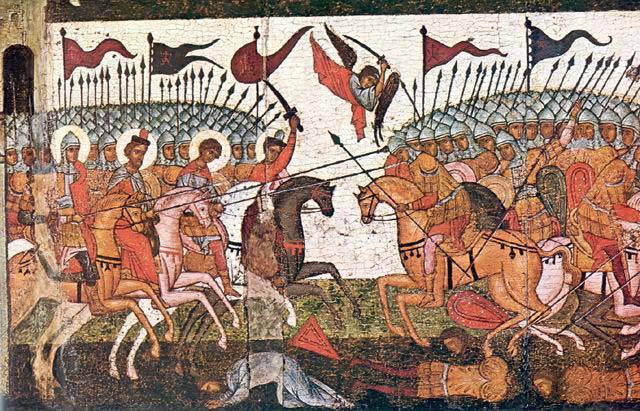
Battle of Novgorod and Suzdal, 1170. Fragment of the 1460 icon. The guards of both cities are armed with spears. Figure Wikimedia Commons
It should be noted that the active study of Slavic and Old Russian copies began relatively recently - at the turn of the XIX and XX centuries. Until then, archaeologists and historians had paid more attention to cold arms or means of protection, while the woody samples were hardly studied. However, at the beginning of the last century, the situation changed, and in just a few decades the gap in knowledge was filled. So, only by the mid-sixties more 750 copies from different regions were discovered and studied. Over the next half century, the number of objects found has increased significantly.
Search for the best
The gunsmiths and warriors of Ancient Russia — like their colleagues and rivals from other countries and regions — were constantly searching for new designs and spear variants capable of providing an increase in combat characteristics. As a result of this, for several centuries many structures have been introduced and tested in practice. New spears differed from the existing shape and size of the tip, the parameters of the shaft, etc.
With the study of archaeological finds, Soviet and Russian historians have long come to an interesting conclusion about the development of ancient Russian spears. It is believed that our ancestors did not focus on the invention of completely new weapon designs. They preferred to study the existing foreign samples and, if they have any advantages, to adopt ready-made designs. In this regard, some Old Russian spears resemble weapons from western countries, while others show eastern influence.
However, there was also inventive activity. Apparently, it was in Russia that a weapon like a spear was invented and massively spread - a special heavy spear with a reinforced tip. At the time of the appearance of such weapons, its direct counterparts from other nations were absent. Moreover, in some foreign languages, a modified Russian word is used to designate such a spear.
Thus, the ancient Russian gunsmiths saved time and energy on finding completely new solutions by studying and introducing someone else's experience. Of course, this did not allow them to be fully leaders of their industry, but it gave other well-known advantages. One way or another, as subsequent events showed, such an approach provided the necessary contribution to the combat capability of the troops.
A characteristic feature of the Old Russian copies is their utilitarian appearance. Unlike other nations, the Slavs almost did not pay attention to the decoration of their pole arms. In particular, there are no significant number of tips with silver ornaments on the sleeve, characteristic of Scandinavia. It is curious that this fact, among other things, was interpreted as evidence of the presence of developed local production of armaments.
Weapon evolution
For many centuries, the Old Russian and foreign gunsmiths constantly refined and changed the shape of the spear tip, seeking to improve its fighting qualities. As a result, a large number of forms and classes of such products are known both in our country and abroad. In the case of the shafts, the situation is much simpler.
The shafts did not differ in the complexity of the design and in fact represented a stick of the necessary length and thickness. In most cases, the length of the shaft corresponded to the average growth of the infantryman or was slightly different from it. The diameter of this part provided the convenience of holding and was approximately equal to 25 mm. A spear with such a shaft weighed no more than 350-400 g, which did not make it difficult to work with it. Spears for riders changed over time and acquired new features. Thus, the length of the pole of such a weapon could reach 2,5-3 m, and its diameter increased to 30-35 mm. The longer and thickest shaft helped to “reach” the enemy on the ground or on horseback, and also withstood a more powerful blow.
However, from the historical and technical point of view, the tips of the spears are of the greatest interest. The oldest in the context of ancient Rus are lanceolate-type tips - such weapons became widespread by the beginning of the 10th century. Such a design, borrowed from the Vikings, was distinguished by a relatively long feather of a rhombic cross-section, smoothly passing into the sleeve. As it developed, the lanceolate spear changed. Its length decreased and the proportions of the pen varied. Around the XI century, such a weapon fell into disuse due to the advent of more sophisticated models.
In place of the lanceolate tip came the so-called. peaked In this case, the spear pen had the shape of a high equilateral triangle. The cross-section of the tip was rhombic and increased along the sleeve. It is curious that the peak tip was very successful and effective. The relative perfection of the design allowed him to remain in operation for the next few centuries.

Oblong-ovate tip. Photo Swordmaster.org
In the same X century, the Old Russian warriors mastered another type of tip. It was made in the form of a tetrahedral rod-blade connected to the sleeve in the form of a funnel. Such a tip could have a rhombic or square cross section. In addition, cross-sectional specimens are known. Spears of similar design can be considered direct ancestors of later peaks that appeared after several centuries. In this case, the gap in time between the two types of weapons was not too large: spears with a tetrahedral tip remained in service until the XIII century.
Another interesting novelty of the X-XI centuries is considered the so-called. A harpoon is a flat arrow-shaped tip with a pair of spikes in the back. Such tips are found in the graves of the X-XIII centuries, but in most cases it was a question of hunting weapons. The two-ship spear-harpoon had limited capabilities in the context of infantry or equestrian combat, and therefore quickly ceased military service.
In the XI century in Russia mastered the new version of the spear tip. It had an oblong-ovate shape with a rhombic cross section, as well as a sleeve of small height. It is curious that a similar form of a spear or arrowhead was created during the Bronze Age and received a certain distribution. Ancient Russia mastered such weapons only at the beginning of the last millennium.
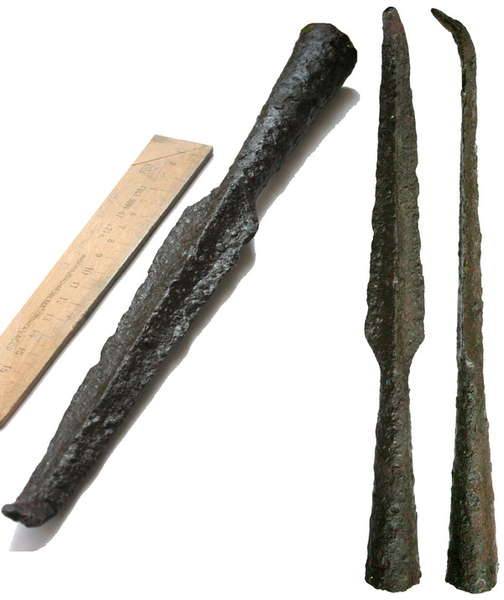
Peak spear. Photo Swordmaster.org
The development of the oblong-ovate tip is the product of the so-called. laurel-shaped forms. In the 12th century, the development of defenses and pole weapons led to an increase in the latter’s strike power. Accordingly, it was necessary to strengthen the design of the tip. The laurel tip had curved blades, which gradually diverged in the front half of the product and converged in the rear. The sleeve had a medium length, and its connection with the feather was strengthened. Such spears were actively used until the XIII-XIV centuries.
A variant of the laurel spear was the already mentioned cattle, a heavy spear for solving certain problems. To increase the penetration strength, the end of the ratchet could have a length up to 500-600 mm and a width up to 60-70 mm. The bushing diameter reached 30-50 mm. The total weight of the spear could reach 800-1000 g - more than two times heavier than a “simple” spear. It should be noted that the spears could have tips of different shapes, but the laurel type provided the best combination of strength and fighting qualities.
In the X-XI centuries, so-called petioled tips. If all the other tips had a sleeve mounted on the shaft, the petiolate was fastened to the wooden part with the help of a pointed stem. The latter was literally driven into the pole. The shape of the tip could be any — samples of the lanceolate and leafy types are known. Such weapons were used in the Eastern Baltic and other northwestern regions. However, these spears did not receive more distribution, and soon they were abandoned. The scape did not provide reliable retention of the tip on the pole, and besides, with strong punches, it could destroy the latter.
On foot and on horseback
For obvious reasons, the spear was originally an infantry weapon. However, the emergence and development of cavalry has led to new ways of using such weapons. As a result, until the very end of the service, the Old Russian spears were used by both the main "branches of the military." In addition, parallel spears were used in another area. In ancient times, such a weapon appeared as a tool for hunting, and retained such functions for many millennia. Naturally, infantry, cavalry and infantry spears had certain differences related to the peculiarities of their use.
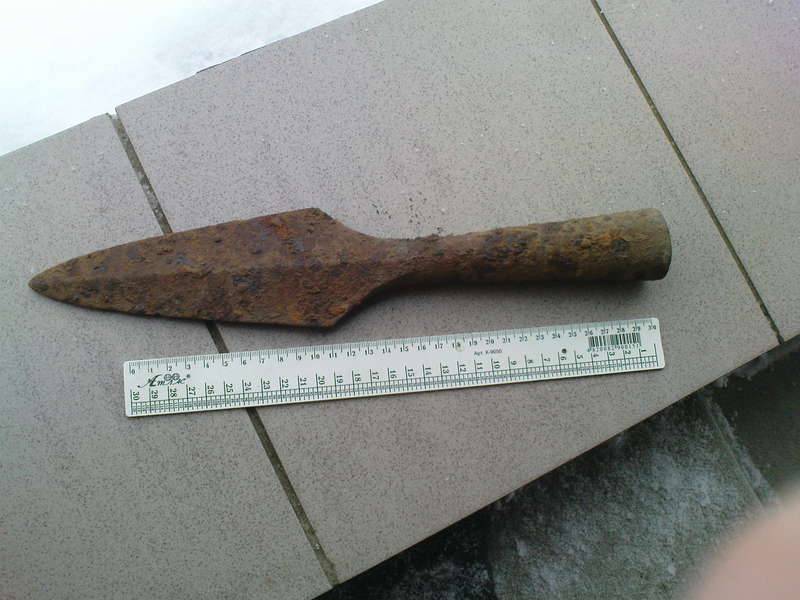
The tip of the spear. Photo Swordmaster.org
Spears for infantry differed in the smaller sizes and weight. Their total length rarely exceeded 1,7-1,8 m, and the mass was usually within 300-400 g. With such parameters, the weapon combined the convenience and sufficient fighting qualities. With the development of defenses, cavalry needed larger and heavier spears, capable of increasing the blow to the enemy. For these reasons, the length of the products reached 2,5-3 m, and the weight increased by more than two times.
It should be noted that infantry and cavalry could use spears with tips of the same types. Depending on the application, they differed from each other only in size and weight. As new types of tips were studied and introduced, re-equipment of both foot and mounted soldiers was made.
The situation in the hunting field changed differently. Initially, the spear of a “military” specimen with tips of actual types was used to hunt large and dangerous animals. However, over time, by the XI-XII centuries, new trends have emerged. In the course of numerous battles, it was found that the heavy double-hinged harpoon did not show itself in the best way in combat. At the same time, this product was distinguished by high efficiency when hunting for an animal. The rear spikes of the tip could cling to the edges of the wound and did not allow the spear to be removed, increasing the impact on the target. On the battlefield, this property turned out to be unnecessary, but was useful in hunting. Another popular tool for hunting was spear-spear, also effective in war.
The turn of the ages
In the late Middle Ages, new types of weapons appeared that changed the situation on the battlefield. However, this did not lead to the abandonment of pole weapons. Spears were used and developed until the XV-XVI centuries, when they were replaced by more sophisticated and effective peaks. Also during this period, the cattle continued to develop, still being an effective means of defeating infantry and cavalry. At the same time, a completely new pole weapon was being developed.
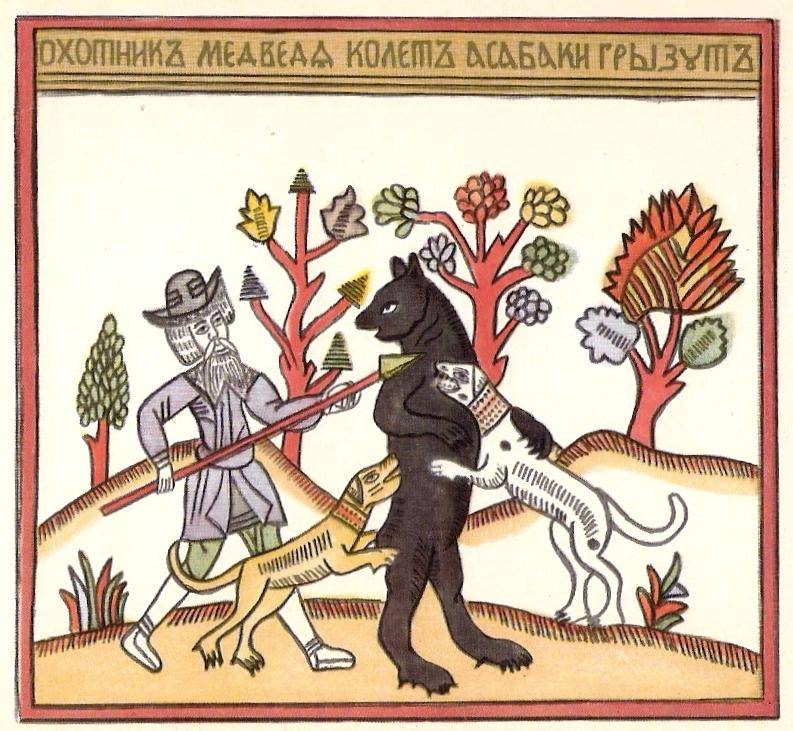
Use spear spears on the hunt. 18th Century Lubok, Wikimedia Commons
The development of means of protection and the emergence of new weapons constantly changed the situation on the battlefield, and also presented new requirements for existing weapons. However, with all such changes, some classes of weapons remained in service for many centuries. A prime example of this is the spear. It remained in service with various formations for more than a thousand years and contributed to the combat capability of the troops. In the future, it was the spears and the experience of their combat use led to the appearance of new types of pole arms, which gradually replaced them.
Old Russian gunsmiths sought to follow current trends in the field of weapons and adopted someone else's experience; borrowed and developed the development of foreign colleagues. Because of this, they managed to create a large number of types of infantry and cavalry weapons, including a whole set of various copies. Spears of all kinds, along with other cold, pole and throwing weapons, ensured high combat effectiveness of troops for many centuries, and thus made a significant contribution to the construction and protection of the Russian state.
Based on:
https://swordmaster.org/
http://rusdarpa.ru/
https://slmogu.ru/
Kirpichnikov A.N. Old Russian weapons. 2 release. Spears, sulits, battle axes, maces, tassels of the 9th – 13th centuries. (AIS. Issue. E1-36). - ML: Science, 1966.
Archeology of the USSR. Ancient Russia. City. Castle. Village. Under the general editorship of Academician B.A. Rybakova. - M .: Science, 1985.
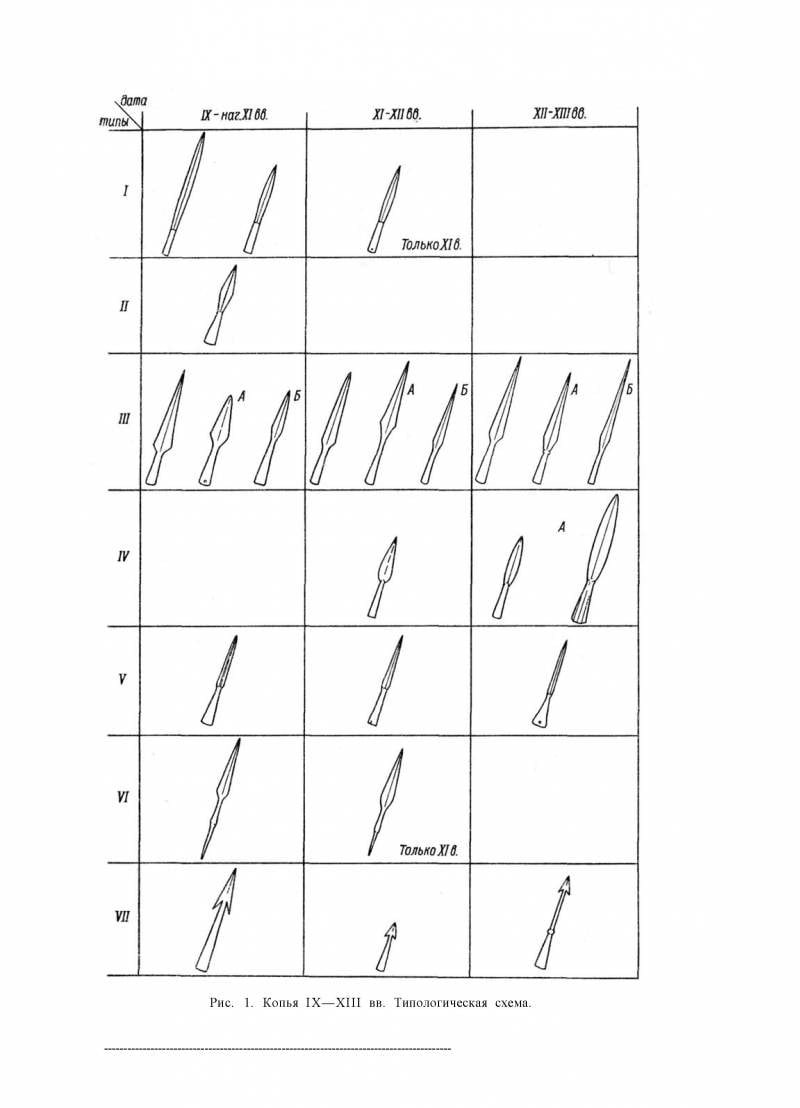

Information